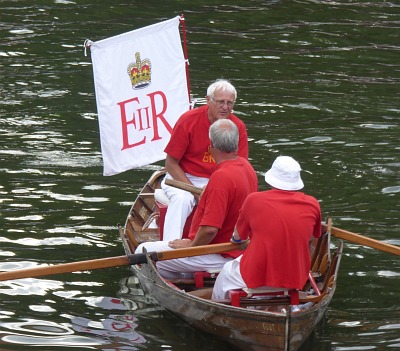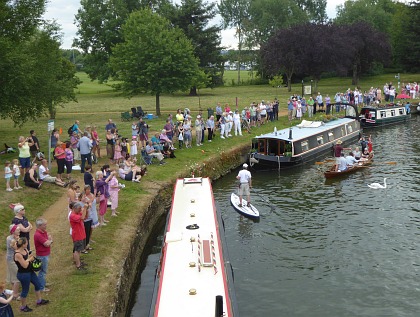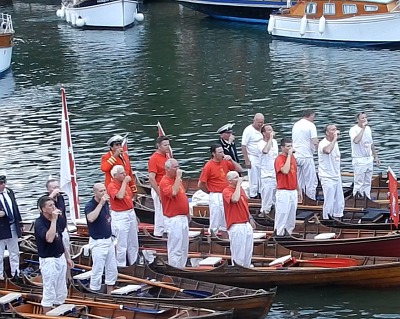
The swan upping boats arrived in Abingdon at around 5pm this afternoon after 5 days on the River Thames.

This annual census of the swans has seen a decline in numbers in recent years. In 2016 I heard that 74 cygnets were counted, that compares with 83 cygnets in 2015 and 120 in 2014.
I have not seen the pair of swans with cygnets that were on the mill stream and near the lock earlier in the year. I do not know what happened to them.

Thanks to Elizabeth for these pictures. I got there too late, because of work, and the excitement was over and the Royal toast had been made.
Elizabeth is putting on an exhibition on 1950s Abingdon over the week of Heritage Open Day in Abingdon (60 years since the Queen visited to re-open the museum). So if anybody has any pictures from that era please get in touch. Email backstreet60@gmail.com and I will pass on your details.
Talking of water birds…Has anyone seen the heron again? The one that used to roost in the Old Gaol willow? (incidentally, when ARE Abingdons favourite chosen builder going to replace that..as instructed by the Planning dept?)
There is often a heron in the circus field on Copenhagen Drive
we still have one who visits regularly to pinch fish from our pond, but I dont know where it roosts
Easy answer to the decline, fish are not the only source of food regularly taken by our “foreign guests” for food, duck, goose and swan are also on their menu, talking to a fisherman last who fishes the Thames at Sandford and regularly sees entire families have a BBQ courtesy of the Thames!
Guess I may have touched upon a non PC subject again ? Well for all the doubting Thomas’s think of it like this, the pair of swans that raised 8 signets last year are still here, this year they nested at the sailing club, they hatched 5 cygnets three weeks ago, last week there were 4 left, today ( a month from hatching) there are none! Q, what would predate a cygnet? If it were very young a mink and a good sized pike would, a bit older an otter might? From then on it can only be man, a cygnet, a suckling pig ,squab, it’s all food, isn’t it ?
Now here’s a thing in an earlier post I reported how an African man had asked me about fishing here and how he’d just arrived?
He’s just walked by with two wives and 7 children
I’ve seen a heron coming and going in the field above the lock before you get to the swift ditch, it often seems to stand in one of the trees close to the ditch but a few times I’ve seen it take off and cross back over the Thames heading in the direction of Radley Lakes, I’ve also seen one in the reeds close to where the hydro project would have been, if it’s standing still it is almost perfectly camouflaged.
The Queen’s swan marker (yes, there is such a person) has reported that the annual census shows a fall in cygnets this year (72 this year, 83 last year). He suggests three main causes: mink, dogs whose owners do not keep them under proper control and dogs. Other causes are that some swans kill themselves by flying into overhead wires, while others die from oil pollution. The orphaned cygnets then lose parental protection. The increase in boating (oil pollution) also means that moorings are taking away nesting sites.
Numbers do fluctuate. In 1985 only seven breeding pairs were found wih cygnets.
Perhaps their habitat is being taken over by the thousands of Canadian Geese up and down the thames. They breed like rats.
Sorry, dogs should not appear as two causes: the third cause was anglers who lines choke the swans.
My mistake and I apologise.
There is a Heron that is often seen hunting at the weir on the Ock walk at the Tesco end.